
Broderbund Software, Inc. was an American maker of video games, educational software, and productivity tools. Broderbund is best known for the 8-bit video game hits Choplifter, Lode Runner, Karateka, and Prince of Persia, as well as The Print Shop—originally for printing signs and banners on dot matrix printers—and the Myst and Carmen Sandiego games. The company was founded in Eugene, Oregon, and moved to San Rafael, California, then later to Novato, California. Brøderbund was purchased by SoftKey in 1998.

Where on Earth Is Carmen Sandiego? is an American live action/animated television series based on the series of computer games. The show was produced by DIC Productions L.P. and originally aired from 1994 to 1999, on Saturday mornings during FOX's Fox Kids Network block. Reruns aired on the Qubo television network from June 9, 2012 to May 26, 2018.
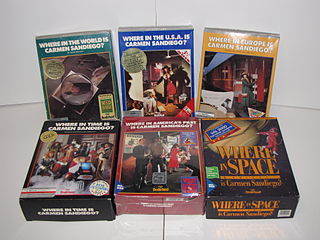
Carmen Sandiego is a series of American educational mystery video games that spawned an edutainment franchise of the same name. The game released in 1985, Where in the World Is Carmen Sandiego?, started off both the video game series and the franchise as a whole, which has continued up to the present day. Each game of the series has a particular theme and subject, where the player must use their knowledge to find Carmen Sandiego or any of her innumerable henchmen. This series was originally owned by Broderbund, but is now owned by Houghton Mifflin Harcourt. Since its initial release the series has won over 125 awards and accolades.

Carmen Sandiego is a media franchise based on a series of computer games created by the American software company Broderbund. While the original 1985 Where in the World Is Carmen Sandiego? video game was classified as a "mystery exploration" series by creators and the media, the series would later be deemed edutainment when the games became unexpectedly popular in classrooms. The franchise centers around the fictional thieving villain of the same name, who is the ringleader of the criminal organization V.I.L.E.; the protagonists are agents of the ACME Detective Agency who try to thwart the crooks' plans to steal treasures from around the world, while the later ultimate goal is to capture Carmen Sandiego herself.
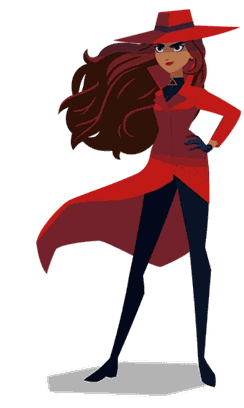
Carmen Isabella Sandiego is a fictional character featured in a long-running edutainment video games series of the same name created by the American software company Broderbund. As an international lady thief, a criminal mastermind, and the elusive nemesis of the ACME Detective Agency, Carmen Sandiego is the principal character of the video game series and the head of ACME's rival organization, V.I.L.E. She is depicted as an extremely intelligent, stylish, fashionable woman whose signature look features a red, matching fedora and trenchcoat. Many of her crimes depicted in the games involve spectacular and often impossible cases of monument theft, which are used as a pretext to teach children geography via the simulated process of tracking down the character, the stolen monuments, and her accomplices all over the world.

Carmen Sandiego's ThinkQuick Challenge is a "game show-themed" edutainment computer game for kids ages 8–12. The title, which is a part of the Carmen Sandiego franchise, was released by The Learning Company on June 1, 1999. It can be played by up to 4 players, and runs on the Mohawk engine.

Where in Time Is Carmen Sandiego? is a multiplatform video game where players have to travel through time to collect clues and the warrants necessary to capture Carmen Sandiego or her henchmen. The goal of this game is to track Carmen's villains through history and arrest them and ultimately arrest Carmen herself.
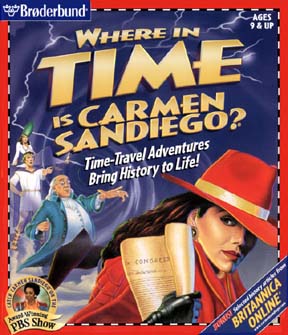
Carmen Sandiego's Great Chase Through Time is a 1997 edutainment point-and-click adventure game developed by Broderbund for Microsoft Windows and Macintosh devices. The game is a remake of the 1989 time-travel title Where in Time Is Carmen Sandiego?, making it the second Time video game in the Carmen Sandiego franchise. The game was strongly influenced by the short-lived PBS game show, Where in Time Is Carmen Sandiego?. The game was previewed at the 1997 Toy Fair in New York City. A demo version was included on the CD for Carmen Sandiego Word Detective and was available on the Carmen Sandiego website. After Broderbund was sold to The Learning Company, the game was re-released with the new title - Carmen Sandiego's Great Chase Through Time - but with minimal redesign.

Where in the World Is Carmen Sandiego? is a 1996 video game part of the Carmen Sandiego franchise. It was the third version of the game, after the 1985 original title of the same name and a 1992 Deluxe version of said game. The game's release coincided on the heels of the end of the PBS game show, and features QuickTime videos of Lynne Thigpen reprising her role as "The Chief". This was the last version of the game to follow the "classic" formula of the series, but much of the game, especially the "warrant" portion, was heavily redesigned. The Deluxe Edition released in 1998 added speech welcoming the player to each country and an "ACME Global Language Link-Up" satellite which quizzed the user on the local language. Players also received a spy watch and "an introduction to 12 foreign languages".

Carmen Sandiego: Junior Detective is a 1995 education game in the Carmen Sandiego franchise developed by Broderbund. Although not a version of Where in the World Is Carmen Sandiego? by name, it is essentially a simplified version of it for pre-readers. Allgame says the game "is geared for younger users, with only 14 cases to solve". The lead characters of the FOX animated series Where on Earth Is Carmen Sandiego?, Zack and Ivy, were included in the game, along with Stretch - "ACME's crime-tracking dog".
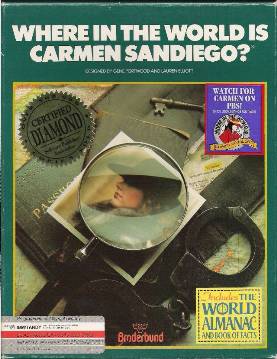
Where in the World is Carmen Sandiego? is an educational video game released by Broderbund on April 23, 1985. It is the first product in the Carmen Sandiego franchise. The game was distributed with The World Almanac and Book of Facts, published by Pharos Books. An enhanced version of the game was released in 1989, which did not have the almanac-based copy protection and instead used disk-based copy protection. A deluxe version was released in 1992, and featured additional animation and a reworked interface from the original version. Some of the bonus features included digitized photos from National Geographic, over 3200 clues, music from the Smithsonian/Folkways Recordings, 20 villains, 60 countries, and 16 maps. CD-ROM versions for DOS and Macintosh were released in 1992, and a Windows version was released in 1994.

Where in the U.S.A. Is Carmen Sandiego? is a video game that was released by Broderbund in 1986 and is part of the Carmen Sandiego series. The game is a sequel to 1985's Where in the World Is Carmen Sandiego?. A deluxe version with updated graphics and interface was released in 1992 and a remade version was released in 1996. The goal of the game is to track Carmen Sandiego's henchmen across the United States, arrest them, and ultimately arrest Carmen herself. The game received generally positive reviews but some critics compared it unfavorably with its predecessor game, which had a global perspective.

Carmen Sandiego Math Detective is a 1998 Carmen Sandiego video game. It is similar in structure to Carmen Sandiego Word Detective, which was released a year before.

Where in America's Past Is Carmen Sandiego? is the 5th educational video game in the Carmen Sandiego series. It was produced by Broderbund and released in 1991.

Where in Space Is Carmen Sandiego? is an educational video game by Broderbund and Electronic Arts.

Where in Europe Is Carmen Sandiego? is a 1988 European geography-based educational computer game in the Carmen Sandiego detective mystery franchise. It was originally published by Broderbund in 1988 for Apple II, Commodore 64, and DOS, and ported to the Amiga and Macintosh in 1989. It is the third Carmen Sandiego title, after Where in the World Is Carmen Sandiego? (1985) and Where in the USA Is Carmen Sandiego? (1986). Under the guidance of The Acme Agency's chief, the player completes cases to catch Carmen's henchmen; they accomplish this by traveling to European cities to find clues relating to the crook's last known whereabouts, and by gaining enough character data to issue a warrant of arrest. Once the player has captured all 15 thieves, they can pursue Carmen herself.
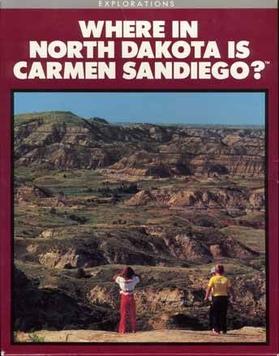
Where in North Dakota Is Carmen Sandiego? is a 1989 edutainment video game. It is the fourth game in the Carmen Sandiego video game series after World (1985), U.S.A. (1986), and Europe (1988). Having observed the popularity of the Carmen Sandiego franchise in the education of school children, educators were inspired to develop a North Dakota version to teach North Dakotans about their state's history and geography.
Carmen Sandiego Days have been popular across United States schools since they were first held in 1988. Inspired by the Carmen Sandiego franchise, these days see schools hold week-long Carmen Sandiego-themed events, aided by packs and prizes originally provided by Broderbund, and later by the franchises' subsequent owners after The Learning Company's acquisition of Broderbund in 1998. The 30th Carmen Sandiego Day took place on January 8, 2018.
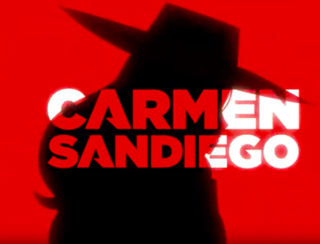
Carmen Sandiego is an animated action-adventure television series with educational elements, based on the media franchise of the same name created by Broderbund. The series is produced by Houghton Mifflin Harcourt with WildBrain serving as the production company, and contains a "serialized look at Carmen's backstory that is told from her perspective". Serving as an origin story for the fictional thieving villain of the same name, it is the fourth Carmen Sandiego television show after the PBS game shows Where in the World is Carmen Sandiego? and Where in Time is Carmen Sandiego?, and the Fox animated series Where on Earth is Carmen Sandiego?; it is also the first Carmen Sandiego related show since the end of Where on Earth is Carmen Sandiego in 1999.

Carmen Sandiego in Japan – Hannin Sagashite Nihon Zenkok is a 1989 spin-off entry in the Carmen Sandiego franchise. It was developed and published by Broderbund Japan on two floppy disks for the NEC PC-9801 Series 525in. The title functions as both an adventure game where players chase and capture Carmen, and an educational game where players learn about geography and history of Japan. The title was released on November 21, 1989, one of the few titles released under the Broderbund Japan brand that year alongside tabletop Shufflepuck Café and shooter Wings of Fury (September).



















